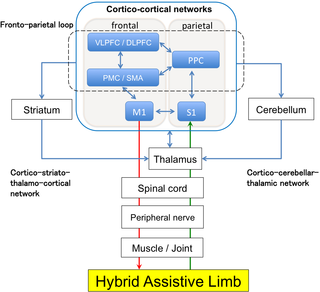PLOS ONE ( IF 3.7 ) Pub Date : 2018-01-16 , DOI: 10.1371/journal.pone.0191361 Kazuya Saita , Takashi Morishita , Hisatomi Arima , Koichi Hyakutake , Toshiyasu Ogata , Kenji Yagi , Etsuji Shiota , Tooru Inoue

|
Introduction
Robot-assisted rehabilitation has been increasingly drawing attention in the field of neurorehabilitation. The hybrid assistive limb (HAL) is an exoskeleton robot developed based on the “interactive biofeedback” theory, and several studies have shown its efficacy for patients with stroke. We aimed to investigate the mechanisms of the facilitative effect of neurorehabilitation using a single-joint HAL (HAL-SJ) and functional near-infrared spectroscopy (fNIRS).
Materials and methods
Subacute stroke patients admitted to our hospital were assessed in this study for HAL eligibility. We evaluated motor-related cortical activity using an fNIRS system at baseline and immediately after HAL-SJ treatment on the same day. Cortical activity was determined through the relative changes in the hemoglobin concentrations. For statistical analysis, we compared the number of flexion/extension movements before and immediately after HAL-SJ treatment using paired t-test. fNIRS used both the methods of statistical parametric mapping and random effect analysis.
Results
We finally included 10 patients (eight men, two women; mean age: 66.8 ± 12.0 years). The mean number of flexion/extension movements within 15 s increased significantly from 4.2 ± 3.1 to 5.3 ± 4.1 immediately after training. fNIRS showed increased cortical activation in the primary motor cortex of the ipsilesional hemisphere immediately after HAL-SJ treatment compared to the baseline condition.
Conclusions
This study is the first to support the concept of the biofeedback effect from the perspective of changes in cortical activity measured with an fNIRS system. The biofeedback effect of HAL immediately increased the task-related cortical activity, and this may address the functional recovery. Further studies are warranted to support our findings.
中文翻译:

混合辅助肢体在中风康复中的生物反馈效应:使用功能性近红外光谱的概念研究
介绍
机器人辅助的康复在神经康复领域越来越受到关注。混合辅助肢体(HAL)是基于“交互式生物反馈”理论开发的外骨骼机器人,多项研究表明其对中风患者的疗效。我们旨在研究使用单关节HAL(HAL-SJ)和功能性近红外光谱(fNIRS)促进神经康复的机制。
材料和方法
本研究评估了入院的亚急性中风患者的HAL资格。我们在基线和当日HAL-SJ治疗后立即使用fNIRS系统评估了运动相关的皮层活动。通过血红蛋白浓度的相对变化来确定皮质活性。为了进行统计分析,我们使用配对t检验比较了HAL-SJ治疗之前和之后的屈伸运动。fNIRS同时使用了统计参数映射和随机效应分析的方法。
结果
我们最终纳入了10名患者(八名男性,两名女性;平均年龄:66.8±12.0岁)。训练后立即在15 s内平均屈伸运动次数从4.2±3.1明显增加到5.3±4.1。与基线状态相比,fNIRS显示在HAL-SJ治疗后即刻,同侧半球的主要运动皮层皮质激活增强。
结论
这项研究是第一个从fNIRS系统测量的皮层活动变化的角度来支持生物反馈效应概念的研究。HAL的生物反馈作用立即增加了与任务相关的皮层活动,这可能解决了功能恢复。有必要进一步研究以支持我们的发现。



























 京公网安备 11010802027423号
京公网安备 11010802027423号